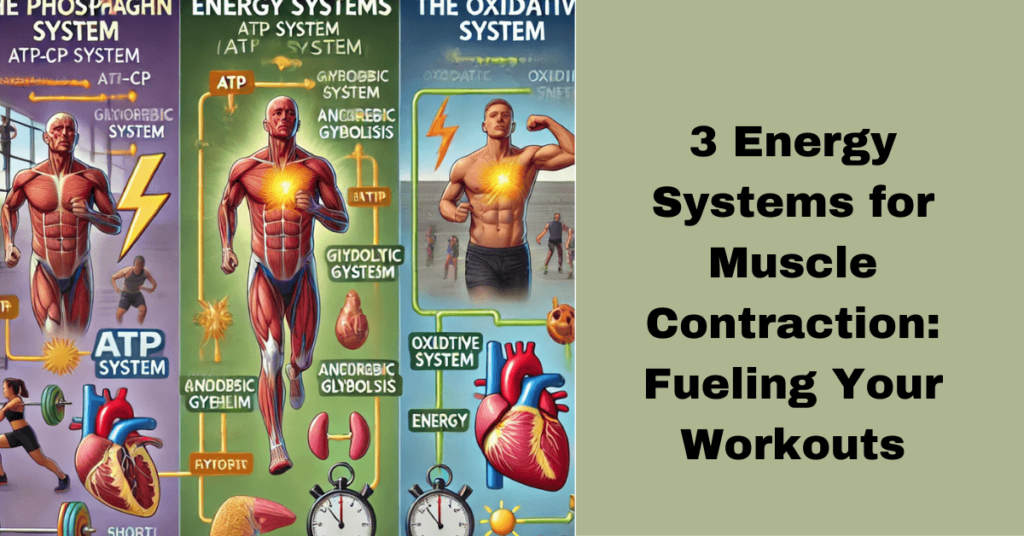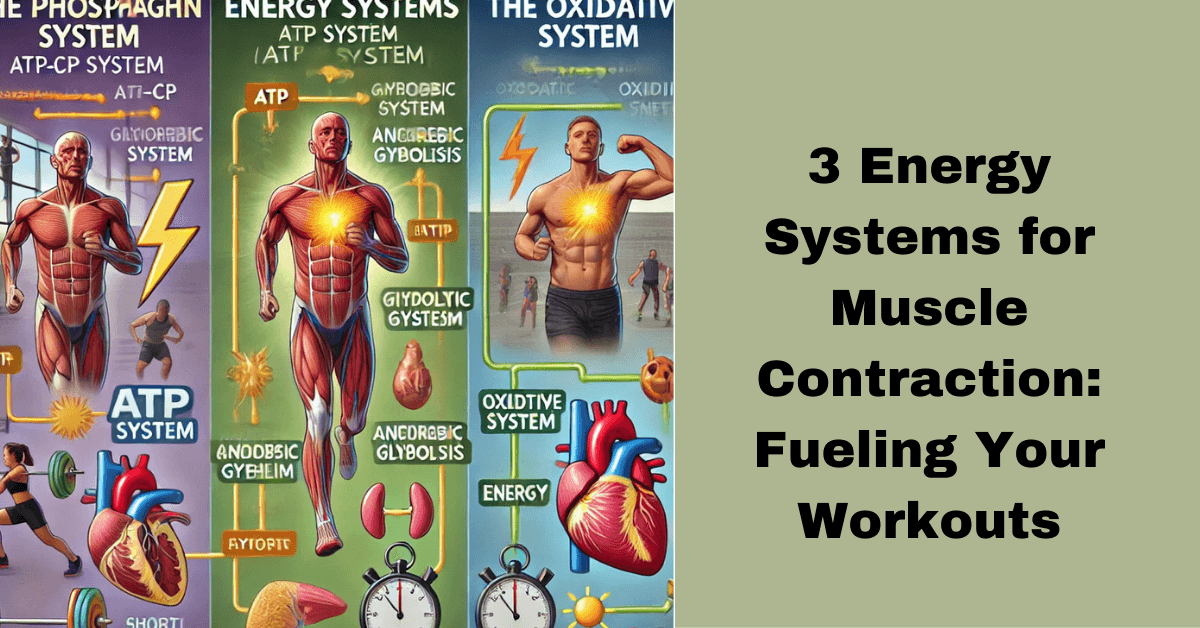Understanding the 3 Energy Systems for Muscle Contraction: Fueling Your Workouts. Muscle contraction is a cornerstone of human movement and physical performance. To power these contractions, the body relies on three primary energy systems. Each plays a unique role in providing the energy needed for different types of activities, ranging from short bursts of power to sustained endurance efforts. This article will explore the 3 energy systems for muscle contraction, breaking down their functions and how they contribute to physical performance.

ATP-PC System: The Immediate Energy Source
The ATP-PC system, also known as the phosphagen system, is the fastest of the 3 energy systems for muscle contraction. It provides immediate energy for high-intensity, short-duration activities such as sprinting, heavy lifting, or jumping.
- How It Works: This system uses adenosine triphosphate (ATP) stored in the muscles and phosphocreatine (PC) to rapidly regenerate ATP. Since the body has limited stores of ATP and PC, this system is only effective for about 10-15 seconds of maximal effort.
- Examples of Activities: Explosive movements like a 100-meter sprint, a maximum bench press, or a high jump.
- Recovery: The ATP-PC system requires rest periods to replenish phosphocreatine stores, usually taking 2-3 minutes.
Key Benefits: The ATP-PC system is crucial for quick, powerful movements and is the first energy system activated during physical activity. Proper training can improve the efficiency of this system, enhancing athletic performance.
Anaerobic Glycolysis: The Short-Term Backup
The anaerobic glycolysis system, also called the lactic acid system, kicks in when the ATP-PC system becomes depleted. It’s the second-fastest of the 3 energy systems for muscle contraction and provides energy for activities lasting up to 2 minutes.
- How It Works: This system breaks down glucose (sugar) without oxygen to produce ATP. However, this process generates lactate as a byproduct, which can cause muscle fatigue.
- Examples of Activities: High-intensity exercises like 400-meter sprints, intense cycling, or a circuit training session.
- Recovery: Active recovery, such as light jogging or stretching, helps clear lactate and speeds up recovery.
Key Benefits: Anaerobic glycolysis allows you to maintain a high level of performance for a slightly longer duration compared to the ATP-PC system. Training this system enhances your ability to sustain moderate to high-intensity efforts and delays fatigue.
Aerobic System: The Endurance Powerhouse
The aerobic system is the slowest but most efficient of the 3 energy systems for muscle contraction. It provides a sustainable energy supply for prolonged, low to moderate-intensity activities by using oxygen.
- How It Works: This system relies on the breakdown of carbohydrates, fats, and, to a lesser extent, proteins, in the presence of oxygen to generate ATP. While slower than the other systems, it can produce much larger amounts of energy.
- Examples of Activities: Endurance events such as marathons, long-distance swimming, or cycling.
- Recovery: The aerobic system supports ongoing recovery during extended periods of physical activity and post-exercise rest.
Key Benefits: The aerobic system is vital for endurance athletes and individuals aiming to improve overall stamina. Regular aerobic training increases cardiovascular efficiency, enhances oxygen delivery to muscles, and boosts metabolic capacity.
How the 3 Energy Systems for Muscle Contraction Work Together
While the ATP-PC, anaerobic glycolysis, and aerobic systems have distinct functions, they don’t work in isolation. Instead, these 3 energy systems for muscle contraction operate on a continuum, depending on the intensity and duration of activity.
- Transition Between Systems: During a 400-meter sprint, for example, the ATP-PC system provides energy for the initial burst, the anaerobic glycolysis system takes over for sustained speed, and the aerobic system supports recovery after the sprint.
- Dynamic Shifts: Activities like soccer or basketball require constant switching between energy systems due to the mix of sprinting, jogging, and resting.
Understanding how these systems interact can help you optimize your training and improve performance.
Training the 3 Energy Systems for Muscle Contraction
To maximize physical performance, it’s essential to target each of the 3 energy systems for muscle contraction through specific training protocols.
- ATP-PC System Training:
- Focus: Short, explosive bursts of high-intensity effort.
- Examples: Sprint intervals, Olympic lifts, plyometrics.
- Work-to-Rest Ratio: 1:3 to 1:5 (e.g., 10 seconds of work, 30-50 seconds of rest).
- Anaerobic Glycolysis Training:
- Focus: High-intensity efforts lasting 30 seconds to 2 minutes.
- Examples: HIIT (high-intensity interval training), 400-meter repeats, or rowing sprints.
- Work-to-Rest Ratio: 1:2 (e.g., 60 seconds of work, 120 seconds of rest).
- Aerobic System Training:
- Focus: Sustained, low to moderate-intensity activities.
- Examples: Long-distance running, cycling, or swimming.
- Work-to-Rest Ratio: Continuous activity or short rest periods.
Incorporating all three types of training ensures a well-rounded fitness program and enhances overall athletic ability.
Common Misconceptions About the 3 Energy Systems for Muscle Contraction
- Myth: Only one energy system is active at a time.
- Reality: All 3 energy systems for muscle contraction are active simultaneously, but their contributions vary based on activity intensity and duration.
- Myth: The aerobic system isn’t necessary for short-duration sports.
- Reality: The aerobic system plays a critical role in recovery between high-intensity efforts.
- Myth: Training one system doesn’t affect the others.
- Reality: Improvements in one energy system often enhance overall performance, as the systems are interrelated.
The Importance of Nutrition in Supporting Energy Systems
Fueling the 3 energy systems for muscle contraction requires a balanced diet:
- Carbohydrates: Essential for both anaerobic and aerobic systems, as they provide quick energy.
- Fats: A primary fuel source for the aerobic system during prolonged activities.
- Proteins: Play a minor role in energy production but are vital for muscle repair and recovery.
- Hydration: Supports metabolic processes and prevents fatigue.
Tailoring your diet to match your training intensity and goals can optimize energy system efficiency.
Why Understanding Energy Systems Matters
Recognizing how the 3 energy systems for muscle contraction function is invaluable for athletes, trainers, and fitness enthusiasts. This knowledge helps:
- Design effective training programs.
- Improve athletic performance.
- Prevent overtraining and injury.
- Maximize recovery and adaptation.
By targeting specific energy systems, you can achieve your fitness goals more efficiently.
Summary: Harnessing the Power of the 3 Energy Systems for Muscle Contraction
The ATP-PC system, anaerobic glycolysis, and aerobic system are the backbone of muscle contraction and physical performance. Each system has a unique role, and together they fuel every movement you make, from explosive sprints to marathon runs.
Understanding and training these 3 energy systems for muscle contraction ensures a balanced approach to fitness and enhances your ability to perform at your best. Whether you’re an athlete or a fitness enthusiast, leveraging these systems will help you achieve your peak potential.

